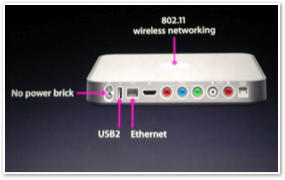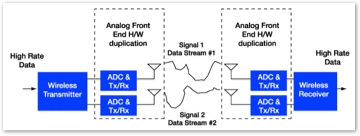





I got some criticism for writing in How Apple's iTV Media Strategy Works that I thought Apple's new iTV was going to incorporate 802.11n, the new and much faster industry standard for wireless networking. Some readers thought that n isn't going to be ready in the timeframe Apple announced for iTV's arrival, while others said 802.11g is plenty fast enough to stream video already.
N: Ready and Willing
Wireless n is most certainly is going to be ready however. Even if the IEEE doesn't get around to filing their papers on the standard, Apple has compelling reasons to deliver n for the iTV, as well as pre-n competition.
 Belkin, D-link, Linksys, Netgear and others have shipped pre-n gear since 2004, so the technology isn't just some far off, futuristic and undeliverable crazy talk.
Belkin, D-link, Linksys, Netgear and others have shipped pre-n gear since 2004, so the technology isn't just some far off, futuristic and undeliverable crazy talk. Remember too that Apple introduced Airport Extreme in January of 2003, prior to the official ratification of its underlying 802.11g, which didn’t happen until six months later in July.
Since final approval of 802.11n is due in July 2007, it won't be a stretch at all for Apple to deliver n in the first quarter of next year.
The real problem for existing vendors is that the various pre-n non-standard implementations aren't compatible with each other, and that that there hasn't yet been a killer app for n.
The Killer App for Wireless N
I've written before about the power of killer apps to develop new markets. The original Mac languished as a curiosity until Aldus PageMaker, Adobe PostScript, and Apple’s LaserWriter suddenly demonstrated why the new computer would be commercially viable.
Apple has since created a network of its own killer apps that feed demand. For example, Apple acquired Final Cut Pro to help sell PowerMac workstations. Digital film editing is so disk intensive that it has since helped drive sales of the Xserve RAID as well. Apple in turn introduced Xsan to spur additional sales.

On the consumer front, Apple introduced built-in iSight cameras, and then wrote applications to make them a useful feature: Photo Booth and iChat AV.
A key factor in Apple's recent success is the continuing effort to develop combinations of raw new technologies along with practical applications for them; neither iChat nor an iSight camera are worth nearly as much on their own as they are together.
Rolling out an improved technology without a real killer application to drive sales has often resulted in the slow death or glacial adoption of many technologies.
That's why USB failed to take off on the PC; there was nothing really driving its adoption. The iMacs' horrific yo-yo mouse suddenly created a huge demand for third party USB mice, and its further lack of legacy ports created a market for other USB peripherals as well.
Apple has found a killer app for wireless n, and is working to deliver it. The iTV is the centerpiece of that strategy.
Wireless Drivers
Remember that the original driver of wireless technology was convenient Internet access. The original Airport, based on the 802.11b specification, delivered faster networking than most users' broadband Internet service.



The next generation, Airport Extreme 802.11g, was significantly faster, but users with existing machines didn't all scramble to update their hardware.
It couldn’t make their web surfing significantly faster, because the bottleneck wasn’t the local wireless, but rather their slow ISP link to outside networks; many users were even still using dial up.
In most cases, the faster g standard was only slowly phased in as a newer generations of computers systems were sold. On Apple's Macs, Airport Extreme networking required more bandwidth than either the older Airport card slots or their USB 1.0 ports could handle, so many users didn't upgrade to g until they got a new machine.
While g offered a significant speed jump, it also had limitations in coverage, particularly in mixed environments. There was no compelling demand for most users to quickly upgrade, because b was often good enough to surf the web wirelessly. Many users continue to use b and g mixed, despite the fact that b devices can slow down g networks and leave their potential untapped.



Apple has also snuck Gigabit Ethernet on all new Macs, despite the fact that most consumers don't yet use the much faster Ethernet standard. For starters, they often have little reason to use blazing fast networking, because home users aren't frequently connecting to local file servers.
The speed of local home networking has lazily chilled out in a comfortable notch well above typical Internet service. However, Apple is about to deliver a huge killer app that will drive demand for both Gigabit Ethernet and the very fast wireless n: streaming HD video.
Why N is Necessary
A number of people have compared the bitrates of Apple's downloadable videos (formerly around 600 kbit/sec, and now the 'near DVD-quality' of around 1500 kbit/sec), and decided that the existing wireless g will be plenty to handle that capacity.
It will, barely, in ideal conditions. However, downloadable iTMS video is going to be among the smallest things consumers will be streaming to the iTV.
Based on existing details, we can only infer that the iTV will also stream high quality video, including DVDs played directly from another Mac. HDMI connectors and component video outputs would certainly be overkill for a device that only does  downloadable 640 x 480 video. However, there are other iTV applications that have much higher bandwidth demands.
downloadable 640 x 480 video. However, there are other iTV applications that have much higher bandwidth demands.
 downloadable 640 x 480 video. However, there are other iTV applications that have much higher bandwidth demands.
downloadable 640 x 480 video. However, there are other iTV applications that have much higher bandwidth demands.Anyone who has browsed shared iPhoto libraries knows that existing wireless speeds are simply sluggish. Steve Jobs also referred to photographs as HD content in the context of showing them off on the iTV.
Anyone wanting to use the iTV's Front Row to view their photos and browse through libraries of available movies will clearly benefit from wireless speeds offered by n.
Conversely, the arguments against the necessity of n also show that n will make the iTV future-proof; many consumers actually won't need to upgrade to n initially, but having it built in means when they do, they'll notice a big jump in the quality and responsiveness available to them. Wireless n will certainly be driven by the iTV.
Upgrading to N
Another interesting facet of wireless n is that it uses new technology to achieve faster data rates. Previous wireless specifications used one antenna on each end; n uses MIMO, or multiple antennas to send different streams over the same frequency. 

Beyond allowing wireless n to be faster, this actually has been observed to make existing b or g wireless devices connect faster and at further distances than when used with an older g basestation.
Of course, existing Airport Extreme cards won't connect at n speeds, but they will hit closer to their own theoretical maximum, which consumers will notice.
That means that even consumers who don't or can't upgrade to n cards in their Macs will still find that the iTV provides them a better, faster, longer range wireless network.
Consumers who upgrade their other machines will obviously notice another major jump. But how much will end users need to pay to go to n? It depends a lot upon what they want to do.
To take advantage of the ability to beam high quality video content to the iTV and view iPhotos and iTunes libraries at top speed, most users will not need to upgrade every wireless Mac and PC to use the iTV.
How many N upgrades?
First, many wireless devices in a typical home won't need to take advantage of n's increased speed. The existing Airport Extreme cards and basestations work fine for streaming audio, and are usable for browsing shared photos and other Front Row style applications.
Second, every device on a network does not need its own wireless connection. In fact, there only has to be one wireless stream in order to take advantage of the much greater speed in wireless n: from the iTV to a central Mac or other n basestation. Other devices can either run at lower speed, or connect via a faster wired connection.
The only scenario that requires a full set of wireless upgrades involves homes with several computers and no wired network, where every computer has its own library of fat content. If you have a home full of wirelessly connected computers, you are probably sufficiently flush to spend for a few wireless card upgrades in order to beam around hi def movies and photos.
For the rest of us plebes, there won't be an overwhelming need to replace an avalanche of wireless cards. Consider the MacBook: I don't know if the existing Airport Extreme card can be upgraded to n, but is it very likely that users will desperately need to beam high def video from a laptop to the iTV? Why not just plop it next to the iTV and plug in the Gigabit Ethernet?
For desktop PCs and iMacs, there are effortless and cheap options for adding wireless n via USB 2.0 or a central wired basestation.
More about the iTV
I complied some reader comments and observations on the iTV as an update to the Sept 13 article, but I’ll repeat them here for readers who didn’t see the changes.
iTunes Remote Control
Reader Jody Sweeton pointed out a new feature in iTunes 7: a preference setting for allowing remote speakers to control iTunes. Sure looks like this is designed to allow a remote device, say an embedded iTV appliance running Front Row, to send control information to iTunes.

This would do the reverse of what I described as a home media center application of The Xserve mini. Rather than having a remote server that acts as a central storage system for iLife content, it looks like Apple is presenting a home’s primary Mac or PC as the digital hub, and positioning the new iTV, and perhaps a new revision of the Airport Express, as a remote player console to manage a central repository on the home computer.
No DVR/PVR or DVD Burner/Ripper?
Lots of people seem worried that the iTV doesn’t have a tuner or hard drive recorder for over the wire or cable TV, nor can it burn, play, or rip DVDs. Well, it also can’t browse the web. Fortunately, any Mac or PC can do all of those things. This device is a video Airport Express, remember?
It’s a way to wirelessly beam high quality audio and video (as well as photos and music) from a Mac or PC for output to a television and stereo system. A lot of effective engineering is about knowing when to stop adding features.
I’m also compelled to point out that I think the iTV should be called Airport AV.
 Remember that the point of the Airport Express is to not just beam audio, but to beam any music, including DRM iTMS songs, to remote speakers. It does this by encrypting the data between iTunes and the Airport Express.
Remember that the point of the Airport Express is to not just beam audio, but to beam any music, including DRM iTMS songs, to remote speakers. It does this by encrypting the data between iTunes and the Airport Express. The iTV will do the same encrypted streaming; that means Apple can play DVDs from a Mac, and hopefully a PC, remotely to the device without facing the wrath of studios worried about users somehow using the DVD in ways they failed to lock down in insane ways. 

Apple might even be able to get away with adding DVD ripping to iTunes, if it encoded the resulting iPod-sized rips to use FairPlay to prevent wholesale duplication and “sharing” of movies. Of course, tools like Mac the Ripper and Handbrake also exist, so its not really necessary.
Many readers also pointed out that the obvious point of the USB connector was to directly connect an iPod dock. That makes sense.
Next Articles:
This Series

| | Comment Preview
 Read more about:
Read more about:

 Send |
Send |

 Subscribe |
Subscribe |
 Del.icio.us |
Del.icio.us |
 Digg |
Digg |
 Furl |
Furl |
 Reddit |
Reddit |
 Technorati
Technorati
Click one of the links above to display related articles on this page.
iTV: the Killer App for Wireless N
Friday, September 15, 2006






Ad







